Warrior tracked armoured vehicle
The Warrior tracked vehicle family is a series of British armoured vehicles, originally developed to replace the older FV430 series of armoured vehicles. The Warrior started life as the MCV-80, "Mechanised Combat Vehicle for the 1980s". One of the requirements of the new vehicle was a top speed able to keep up with the projected new MBT, the MBT-80 - later cancelled and replaced by what became the Challenger 1 - which the then-current FV432 could not. The project was begun in 1972. GKN Defence won the production contract in 1984 and the Warrior was accepted for service with the British Army in November 1984. GKN Defence was purchased by BAE Systems, via Alvis plc.
| FV 510 Warrior | |
|---|---|
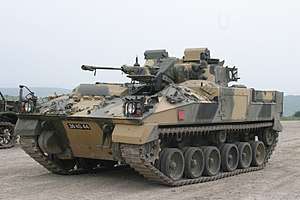 FV510 Warrior Infantry Section Vehicle | |
| Type | Infantry fighting vehicle |
| Place of origin | United Kingdom |
| Service history | |
| In service | 1984–present |
| Production history | |
| Designer | GKN Sankey / GKN Defence |
| Designed | 1972–1980 |
| Manufacturer | GKN Sankey/BAe Systems |
| Produced | 1984 |
| No. built | 1,000+ |
| Specifications | |
| Mass | 25.4 tonnes (25.0 long tons; 28.0 short tons) |
| Length | 6.3 m (20 ft 8 in) |
| Width | 3.03 m (9 ft 11 in) |
| Height | 2.8 m (9 ft 2 in) |
| Crew | 3 (commander, gunner, driver) + 7 troops |
| Armour | Aluminium and appliqué |
Main armament | 30 mm L21A1 RARDEN cannon (current) 40 mm CTA International CT40 cannon (future upgrade) |
Secondary armament | L94A1 coaxial 7.62 mm chain gun 7.62 mm machine gun |
| Engine | Perkins V-8 Condor Diesel 550 hp (410 kW) |
| Power/weight | 22 hp/t |
| Suspension | Torsion bar with hydraulic damper |
Operational range | 410 miles (660 km) |
| Maximum speed | 46 mph (75 km/h) on road, 31 mph (50 km/h) off road[1] |
A total of 789 FV510 and variants were manufactured for the British Army, and 254 of a modified version (Desert Warrior) were produced for the Kuwaiti Army.
Description
The Warrior incorporates several design features in keeping with the UK's battlefield experience. In particular, there are no firing ports in the hull, in line with British thinking that the role of the armoured personnel carrier/infantry fighting vehicle (APC/IFV) is to carry troops under protection to the objective and then give firepower support when they have disembarked. The absence of firing ports also allows additional appliqué armour to be fitted to the sides of the vehicle, which is invariably applied to Warriors involved in active operations. The cage armour used at one stage was replaced in 2007 by "Wrap Two" appliqué armour.[2] The basic armour provides all-around protection against small arms ball ammunition.
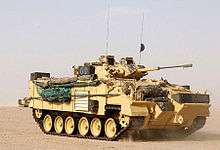
The crew of a Warrior comprises the driver, seated in the front hull, and the gunner and commander, who are both seated in the turret. The embarked infantry section can number up to seven soldiers, who are seated facing each other in the rear hull compartment. Passenger access is through a single electric ram powered door at the rear of the hull, rather than a drop-down ramp as in the US M113 APC and M2 Bradley IFV. Warrior Section Vehicles are able to carry and support seven fully equipped soldiers together with supplies and weapons, including a number of anti-tank weapons, for a 48-hour battlefield day in nuclear/biological/chemical conditions.
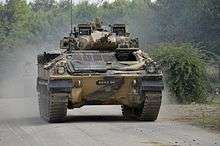
The Warrior is driven by a Perkins-Rolls-Royce V8 Condor engine through a four-speed automatic gearbox. It is capable of a road speed of 46 miles per hour (74 km/h). The Warrior has the speed and performance to keep up with a Challenger 2 main battle tank over the most difficult terrain.
The vehicle is fitted with a two-man GKN Sankey turret, armed with a non-stabilized L21A1 30 mm RARDEN cannon capable of destroying some APCs at a maximum range of 1,500 metres (1,600 yd), and an L94A1 EX-34 7.62 mm Hughes Helicopters coaxial chain gun. It is fitted with two clusters of four defensive grenade launchers (usually used with Visual and Infrared Screening Smoke – VIRSS).
All Warrior Infantry Section Vehicles are now equipped with Bowman radios, which replaced the earlier Clansman radios, for enhanced communications, command and control. When first introduced, the vehicles were fitted with passive Image intensifier night vision sights. These have since been progressively replaced with Thales Optronics Battle Group Thermal Imaging (BGTI) sights to upgrade night fighting capabilities, with 8x magnification.[1] As of 2007, 350 vehicles were fitted with BGTI.
Combat history
- Operation Granby (Gulf War)
- Operation Grapple (United Nations duties in Bosnia with the UNPROFOR)
- Operation Resolute (NATO IFOR (Implementation Force) Bosnia 1996)
- Operation Telic (Iraq from 2003)
- Operation Herrick (Afghanistan with ISAF)
The protection against small arms, missiles, rocket-propelled grenades and anti-tank mines was shown during the UN operations in Bosnia. Two Warriors were destroyed during the First Gulf War, with nine soldiers killed, in a friendly fire incident when hit by an AGM-65 Maverick launched in error by an American A-10 Thunderbolt II.
As of 17 November 2008, 22 soldiers had been killed while travelling in Warrior IFVs in Afghanistan or Iraq.[3] On 7 March 2012, six British soldiers were killed in an explosion that hit a Warrior IFV in Helmand.[4]
Variants
- FV510 Infantry Section Vehicle. This is the principal version operated by the British Army, as described above. 489 were produced (including 105 as platforms for the mobility of ATGW teams, originally equipped with MILAN and later with Javelin).[5]
- FV511 Infantry Command Vehicle. 84 of these were produced.
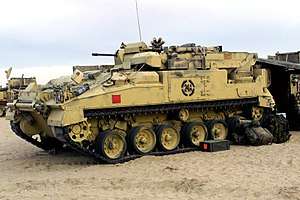
- FV512 Mechanised Combat Repair Vehicle. Operated by REME detachments in Armoured Infantry battalions. It is equipped with a 6.5 tonne crane plus power tools and is able to tow a trailer carrying two Warrior power packs or one Challenger power pack. 105 of these were produced.
- FV513 Mechanised Recovery Vehicle (Repair). Also operated by REME detachments in Armoured Infantry battalions. It is equipped with a 20 tonne winch and 6.5 tonne crane plus power tools and (like the FV512) is able to tow a trailer carrying two Warrior power packs or one Challenger power pack. 39 of these were produced.
- FV514 Mechanised Artillery Observation Vehicle. This is operated by the Royal Artillery as an Artillery Observation Post Vehicle (OPV) and is fitted with mast-mounted Man-packable Surveillance and Target Acquisition Radar (MSTAR) and Position and Azimuth Determining System (PADS), with Image Intensifying and Infra Red equipment. The only armament is the 7.62 mm machine gun, as the 30 mm Rarden cannon is replaced by a dummy weapon. This allows space for the targeting and surveillance equipment while still keeping largely the same outward appearance of a standard Warrior in order to avoid becoming a priority target. 52 of these were produced.
- FV515 Battery Command Vehicle. This is operated by the Royal Artillery. 19 of these were produced.
- Desert Warrior. This was an export version adapted for operations in hostile desert conditions. It was fitted with the Delco turret as used on the LAV-25 wheeled IFV, mounting a stabilised M242 Bushmaster 25 mm chain gun with coaxial 7.62 mm chain gun and 2 x Hughes TOW ATGM launchers (one mounted on each side). In 1993, Kuwait purchased 254 Desert Warrior vehicles.
- Warrior 2000. This was a new version developed for the Swiss Army. It did not enter production. It featured an all-welded aluminium hull, increased armour, digital fire control system and more powerful engine. It was fitted with the Delco turret, or a Land Systems Hagglunds E30 turret with Alliant Techsystems Bushmaster II Mk 44 30 mm cannon.
- Armoured Ambulance. Six Warriors, with armaments removed, were converted to the armoured ambulance role for use in Afghanistan during Operation Herrick.[6]
- VERDI-2 (Vehicle Electronics Research Defence Initiative) was a technology demonstrator built on the hull of an fv510 in 1993. It utilized the CTAi 40mm cannon, in addition to 8 starstreak missiles in 2 quad launchers, as well as the ADAD system later seen on the Stormer HVM. It did not enter production.[7]
Warrior Capability Sustainment Programme
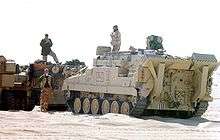
Upgrades already fitted to Warriors in British Army service included the Bowman Communications System and Thales Battle Group Thermal Imaging (BGTI) night sights. However the British Army determined that a bigger upgrade programme was required to extend its service life to 2040.
The Warrior Capability Sustainment Program (WCSP) will involve upgrading 380 Warriors with the Warrior Modular Protection System (WMPS) and Warrior Enhanced Electronic Architecture (WEEA). Within that group, 245 vehicles will also be fitted with a new turret and weapon system under the Warrior Fightability Lethality Improvement Program (WFLIP). The remainder, which will be designated as Armoured Battlefield Support Vehicles (ABSV), will lack turrets and carry out field repair and recovery roles using winch and crane attachments.[8]
BAE Systems and Lockheed Martin competed for the WCSP contracts. Lockheed Martin's WFLIP upgrade was based on the existing Warrior turret. BAE Systems designed a new turret.[9] In March 2011, it was announced that Lockheed Martin had effectively won the competition to develop both the WFLIP and the FRES turrets. Severe budgetary pressures made it uncertain whether these defence projects were to be delayed or curtailed, but it was announced in October 2011 that the Warrior upgrades would proceed at a cost of £1bn, extending the service life of the Warrior to 2040 and beyond.[10][11] The scheduled in-service date for upgraded Warriors was 2018.
Under the WFLI program, the present turret mounting the RARDEN cannon, which lacks stabilisation and is manually loaded with three-round clips, will be replaced by a turret that will mount a stabilised 40 mm weapon developed by the Anglo-French firm CTA International and firing Cased telescoped ammunition.[11][12] This weapon will also equip the Ajax armoured vehicle.
As of March 2020, Warrior CSP is the "demonstration phase", demonstrating capability for a range of military missions set by the MoD. A total of £430m has been spent so far. No in-service date has been set, but the demonstration phase is due to finish in 2021.[13] In June 2020 the House of Commons Defence Select Committee described the project as running over three years late and £227 million over budget.[14]
Operators


See also
Notes
- "Archived copy" (PDF). Archived from the original (PDF) on 19 November 2010. Retrieved 30 October 2014.CS1 maint: archived copy as title (link)
- "Warrior Tracked Armoured Vehicles". Army Technology. Retrieved 26 April 2016.
- Alastair Jamieson (16 November 2008). "New safety fears over Army vehicles after soldier killed". The Telegraph. Retrieved 26 April 2016.
- "Six UK soldiers killed in Afghanistan explosion". BBC. 7 March 2012. Retrieved 7 March 2012.
- "MCV-80 Warrior Infantry Fighting Vehicle". Military-today.com. Retrieved 27 November 2017.
- "Armoured Ambulances". Think Defence. 28 September 2015. Retrieved 11 April 2017.
- "The Nineties". Think Defence. Retrieved 11 May 2019.
- "Archived copy". Archived from the original on 20 December 2016. Retrieved 18 December 2016.CS1 maint: archived copy as title (link)
- "WCSP: Mid-Life Upgrade for Britain's Warrior IFVs". Defense Industry Daily. 23 June 2014. Retrieved 26 April 2016.
- "£1bn upgrade for British army's Warrior vehicles". BBC News. 25 October 2011. Retrieved 25 October 2011.
- "Anthony G Williams : Light AFV guns and the WCSP and FRES Scout projects". quarryhs.co.uk. Retrieved 2 August 2018.
- Testing the Warrior IFV with the new Turret, Armed with the CT40 Cannon. YouTube. 15 December 2009. Retrieved 26 April 2016.
- "Army Technology Warrior CSP update".
- Sheridan, Danielle (26 June 2020). "Royal Navy's £3bn aircraft carriers will end up 'for display purposes only', MPs warn". The Daily Telegraph. Retrieved 26 June 2020.
References
- Foss, Christopher & Sarson, Peter. Warrior Mechanised Combat Vehicle 1987–1994, Osprey UK, 1994, London, New Vanguard Series No. 10.
External links
| Wikimedia Commons has media related to FV510 Warrior. |